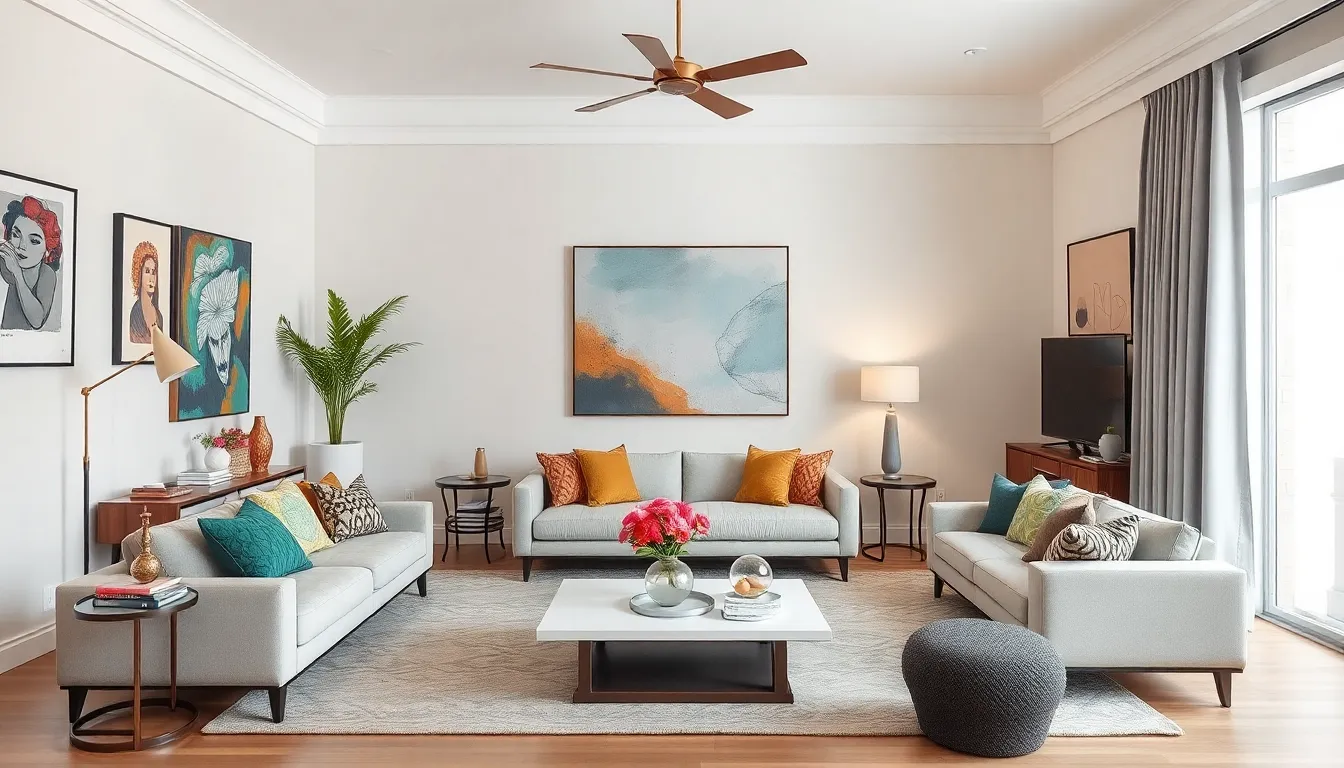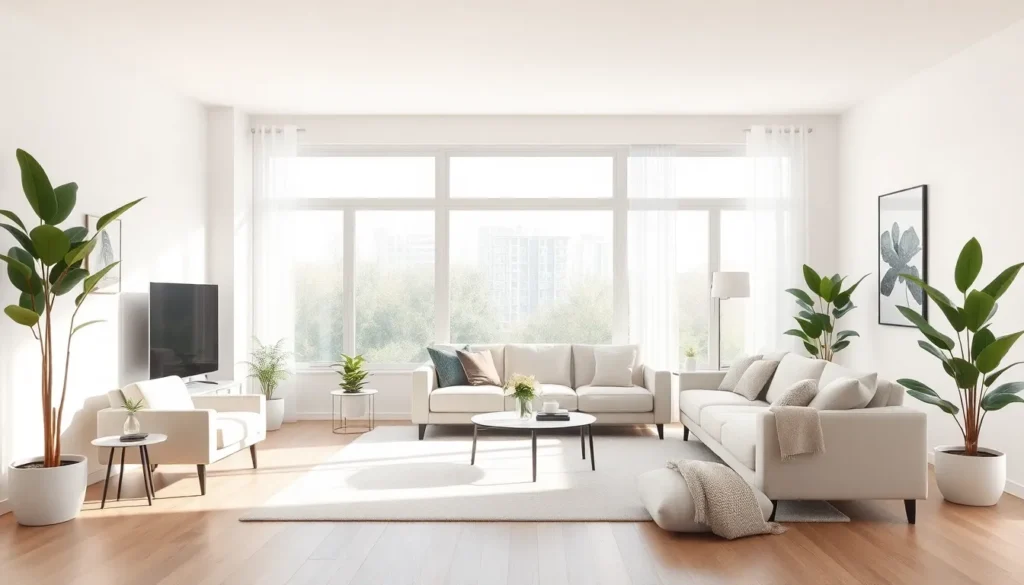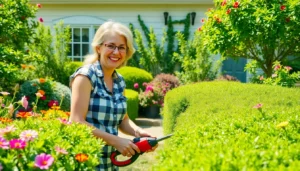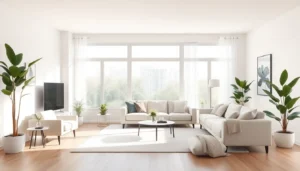In the world of real estate, first impressions are everything. Home staging isn’t just about fluffing pillows and arranging flowers; it’s the secret sauce that transforms a house into a buyer’s dream. As trends evolve faster than a cat meme goes viral, staying updated on what’s hot in home staging can make all the difference.
Table of Contents
ToggleOverview of Home Staging Trends
Current home staging trends focus on creating inviting and functional spaces. Emphasizing minimalism, many homeowners opt for decluttered designs that allow potential buyers to envision their own lifestyle in the home. Neutral palettes dominate, steering clear of overly bold colors that may deter specific buyers.
Sustainability plays a significant role in contemporary staging. Eco-friendly materials and furniture sourced from sustainable brands appeal to environmentally conscious buyers. This trend highlights a commitment to both style and social responsibility.
Enhanced technology integration influences staging practices as well. Smart home devices increasingly captivate buyers by showcasing innovation and convenience. These elements demonstrate modern living, attracting tech-savvy purchasers.
Natural elements such as plants and organic textures also rise in popularity. Incorporating greenery brings life to interiors and promotes a sense of well-being. Using natural light becomes essential as homeowners commit to brightening spaces while enhancing their overall ambiance.
Furniture placement takes on new importance in staging trends. Open floor plans benefit from strategic arrangements that encourage flow and functionality. Adjusting layouts to highlight a room’s best features allows prospective buyers to appreciate the home’s potential.
Lastly, personalization remains a crucial aspect of home staging. Including carefully chosen artwork or accessories reflects the lifestyle buyers aspire to attain. This tailored approach helps create an emotional connection to the space while reinforcing its appeal.
Staying updated on home staging trends enhances the prospect of attracting buyers in a competitive market.
Popular Home Staging Styles

Home staging styles vary widely, reflecting diverse preferences and enhancing appeal. Current trends emphasize creating spaces that resonate with potential buyers.
Minimalist Approach
Minimalism focuses on simplicity and functionality. Using fewer decorative items creates open, airy environments. Neutral color palettes remain popular, allowing buyers to envision their style. Furniture pieces, often sleek and modern, enhance space without overwhelming. Additionally, strategically placed art adds a subtle charm without cluttering. Emphasizing clean lines and geometric shapes contributes to a fresh, uncluttered feel. This approach speaks to those who appreciate a calm, organized aesthetic, making homes feel larger and more inviting.
Maximalist Décor
Maximalist décor embraces boldness and creativity. Rich colors, intricate patterns, and diverse textures combine, showcasing personality. This style encourages using eclectic furniture pieces and unique accessories to make statements. Vibrant artwork and layered textiles add visual interest and warmth. The approach allows homeowners to reflect their individuality, appealing to buyers who value uniqueness. Mixing various styles can excite the senses, transforming a space into an energizing haven. Ultimately, maximalism creates strong impressions, inspiring buyers through its artistic expression.
Color Schemes in Home Staging
Color schemes play a vital role in home staging, creating emotional connections and setting the right tone. Current trends prioritize soothing and neutral palettes, fostering an inviting atmosphere.
Trending Color Palettes
Popular color palettes lean towards soft whites, warm grays, and muted earth tones. These hues appeal to a broad spectrum of buyers and facilitate personal imagination regarding the space. Accent colors, such as muted blues and gentle greens, provide visual interest without overwhelming the senses. With an emphasis on natural light, reflective surfaces enhance existing colors, making spaces feel larger and more open. Each element combines to create tranquil settings that resonate with potential buyers.
Impact of Colors on Buyers
Colors significantly influence buyer perceptions and emotions. Soft neutrals often evoke feelings of calmness and serenity, crucial for making lasting first impressions. Dark shades might discourage potential buyers, while vibrant colors can energize or thrill them. Psychological studies indicate that people react favorably to harmonious color combinations, equating them with comfort and happiness. Strategic color choices enhance perceived value, ultimately supporting the sale and leading to quicker transactions.
Furniture and Accessories
Current staging emphasizes the use of furniture and accessories to create inviting and functional spaces. Selecting the right pieces enhances the overall ambiance and appeal of a home.
Versatile Furniture Choices
Furniture selections play a pivotal role in effective staging. Without overwhelming the space, versatile pieces help maintain a clean and uncluttered look. It’s essential to utilize furnishings that fit various styles, making it easier for potential buyers to envision their lives within the home. Multi-functional items, such as ottomans with storage and extendable dining tables, promote space efficiency. Opting for furniture in neutral tones allows buyers to concentrate on room potential rather than personal taste. Consequently, the inclusion of modern designs blends seamlessly with traditional settings, broadening the target audience.
Role of Accessories in Staging
Accessories contribute significantly to the home staging process. Thoughtfully chosen decor items can evoke emotions and create connections. Art pieces, vases, and decorative pillows add character and warmth without overwhelming the decor. Incorporating plants brings a touch of nature indoors while enhancing air quality. Furthermore, strategic placement of accessories highlights architectural features and adds visual interest. It’s important for staging to represent a curated yet lived-in atmosphere, making spaces feel welcoming and relatable to buyers. Ultimately, the right accessories elevate overall appeal and draw attention to the home’s best features.
Technology in Home Staging
Technology plays an integral role in modern home staging, enhancing visual appeal and broadening marketing reach.
Virtual Staging Innovations
Virtual staging innovations significantly transform the home staging process. These digital tools allow professionals to create photorealistic images of spaces with virtual furniture and decor. Homeowners can visualize potential layouts without the costs associated with physical staging. Cost-effective and efficient, virtual staging appeals to tech-savvy buyers who appreciate modern presentation styles. Companies like BoxBrownie and Virtually Staging Properties offer services that cater to this growing trend, enabling sellers to showcase their homes in the best light.
Digital Marketing Strategies
Digital marketing strategies complement home staging by showcasing properties effectively online. High-quality photographs, virtual tours, and engaging video content attract more potential buyers to listings. Social media platforms amplify reach, allowing agents to highlight staged homes with targeted ads. Search engine optimization techniques ensure homes appear prominently in search results, increasing visibility. Real estate websites featuring staging tips and insights can drive traffic, directing interested clients to listings. Integrating these digital tactics maximizes buyer engagement and enhances the overall success of home staging efforts.
Staying ahead in home staging trends is vital for anyone looking to sell a property successfully. By focusing on inviting and functional spaces that resonate with potential buyers, sellers can make their homes stand out. Embracing minimalism and sustainability while integrating technology creates a modern appeal that attracts today’s buyers.
The thoughtful selection of colors and furniture not only enhances the aesthetic but also fosters emotional connections. As the real estate market continues to evolve, adapting to these trends will ensure homes remain competitive and appealing. With the right approach to staging, sellers can significantly increase their chances of a quick and profitable sale.





